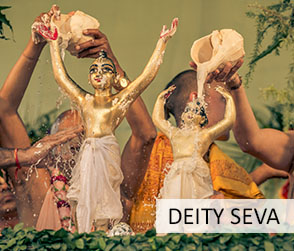V rindavan das Thakura is the author of Sri Caitanya Bhagavat. He is none other than Vedavyasa, the author of Srimad Bhagavatam, who appeared in Gaura lila as one of the associates – Vrindavan Das Thakur. At Modadrumadvipa, popularly known as Mamgachi in Navadvipa Mandala is his birthplace. On this most sacred disappearance day, many devotees visit Mamgachi to his Sripat to have darshan and blessings.
Vrindavan das Thakur – life & edicts:
vedavyaso ya evasid daso vrindavano’dhuna
sakha yah kusumapidah karyatas tam samavishat
Vedavyasa became Vrindavan Das Thakur. Krishna’s friend Kusumapida also entered into him for special purposes. (Gaura-ganoddesha-dipika 109)
Vedavyasa described Krishna-lila in the Srimad Bhagavatam. Non-different from Vyasa, Vrindavan Das described Mahaprabhu’s lila in his Chaitanya Bhagavat. His book was first called Chaitanya Mangala, but when Locana Das gave the same name to his biography of the Lord, it was dubbed “Chaitanya Bhagavat”.
Vrindavan Das’s Mother, Narayani
Vrindavan Das was born on the Krishna-dvadashi of the month of Vaishakh in 1429 of the Shaka era (1507 AD). Some say he was born in Mamgachi in the Nabadwip area, others say his birthplace was in Kumarahatta. His father was Vaikunthanatha Vipra, who originally came from Sylhet (Sylhet), his mother Narayani Devi. Narayani was the daughter of Srivasa Pandit’s elder brother, Shrinalina Pandit. Kavi Karnapura has also mentioned her name in his Gaura-ganoddesha-dipika:
ambikayah svasa yasin namna shrila-kilimbika
krishnocchishtam prabhuïjana seyam narayani mata
Kilimbika, who used to eat Krishna’s remnants, was the younger sister of Krishna’s nurse Ambika (Srivasa’s wife, Malini). In Mahaprabhu’s lila, she became Narayani.
Narayani also achieved fame because she received Gaurasundara’s mercy when he gave her his remnants. When the Lord displayed his divine form in the Mahaprakasha in Srivasa Angan, Narayani was only a small child of four, but the Lord made her intoxicated with the ecstasy of prema. Whether born in Mamagachi or in Kumarahatta, Vrindavan Das later lived in the village of Denuria, within the Matreshvara precinct of Burdwan district. Thus Denuria is considered to be his Shripata. He spent some of his childhood with his mother in Mamagachi, at the home of his maternal grandparents where Narayani was married. Vrindavan Das’s Gaura-Nitai deities are still worshiped at the Mamagachi home. When his father died, he and his mother moved to Srivasa’s house where he received Mahaprabhu’s special blessings.
Vrindavan Das Writes Chaitanya Bhagavat
Because of the copious blessings he received from Nityananda Prabhu, Vrindavan Das is said to have been his initiated disciple.
Vrindavan Das is the recipient of Nityananda’s blessings. He is the original Vyasa of Chaitanya’s pastimes. (Chaitanya Charitamrita 3.20.82)
He wrote Chaitanya Bhagavat in 1535 AD. Krishnadas Kaviraj Goswami, the author of Chaitanya Charitamrita, has written the following in praise of Vrindavan Das Thakur:
Vrindavan Das, the son of Narayani, wrote the Chaitanya Mangala. Vedavyasa described Krishna’s life in the Srimad Bhagavatam and Vrindavan Das is the Vyasa of Chaitanya-lila. (Chaitanya Charitamrita 1.11.54-5)
Just as Vyasadeva compiled Lord Krishna’s pastimes in Srimad Bhagavatam, Thakur Vrindavan Das depicted Lord Chaitanya’s pastimes. His Chaitanya Mangala annihilates all misfortune. From it, I learned the wonders of Lord Chaitanya and Nityananda and came to know all the most subtle doctrines of devotional service to Krishna. Vrindavan Das Thakur has summarized the essence of the teachings of the Srimad Bhagavatam in his Chaitanya Mangala. If even a Muslim or an atheist should listen to Chaitanya Mangala, he immediately becomes a great Vaishnava. An ordinary human being could not have composed such a sublime work; Lord Chaitanya himself has spoken through the mouth of Vrindavan Das. I offer millions of obeisances unto the lotus feet of Vrindavan Das Thakur who has delivered the entire universe through his book. He was born in the womb of Narayani who eternally enjoys Sri Chaitanya’s remnants. How wonderful is his description of the activities of the Lord, simply by hearing which the three worlds have become sanctified! (Chaitanya Charitamrita 1.8.34-42)
Vrindavan Das became so absorbed in the description of Nityananda Prabhu’s lila that he did not elaborately relate all of Mahaprabhu’s activities, only summarizing them in abbreviated form. Krishnadas then elaborated on these undescribed activities in his Chaitanya Charitamrita.
Vrindavan Das the authorized biographer of Sri Chaitanya Mahaprabhu and equal to Srila Vyasadeva. He has described the Lord’s pastimes in such a way as to make them sweeter and sweeter. I shall try as far as possible to fill in the accounts he left out of fear of excessively enlarging his book. (Chaitanya Charitamrita 1.13.48-9)
Vrindavan Das’s Criticisms of Vaishnava Aparadha
Vrindavan Das primarily wrote on Mahaprabhu’s early activities such as his pastimes as a student, his childhood, his chastisement of the Qazi, his departure from Nabadwip, as well as some aspects of his life in Puri. Vrindavan Das Thakur demonstrated infinite mercy on the fallen souls by warning them:
eta parihare-o je papi ninda kare
tabe lathi maron tar shirera upare
Even after being told how objectionable it is, if someone still blasphemes the Vaishnavas, then I will kick him in the head.
These same words are repeated in the Adi, Madhya and Antya-khandas of the Chaitanya Bhagavat. Some foolish and arrogant persons misunderstand such statements and criticize Vrindavan Das for having made them. Such criticism leads them into the mud of offensiveness. In this connection, the remarks of Srila Bhaktisiddhanta Saraswati Goswami Thakur, the founder of the Sri Chaitanya Math and all the Gaudiya Maths, are well worth studying: “‘I am ready to kick the heads of those envious and hellish persons who blaspheme Nityananda Prabhu, if by so doing I will be able to forever prevent them from repeating their attempts to show disrespect for the Supreme Lord. Not only that, but if by so doing I can bring about a slear conception of the truth, I will be performing them the greatest service.’
“So says Vrindavan Das, the incarnation of Vyasa and acharya of the Vaishnava faith. If even a single fleck of dust should fall from his foot on the head of a sinful blasphemer, then that person will be blessed and all his sinful conditioning will inevitably be eradicated. In words which embody the Goddess of Learning and a flood of pure devotion, the Thakur reveals compassion for even the most atheistic blasphemer with the unswerving faith appropriate to a servant of Nityananda Prabhu, the supreme guru. He tells them that though they should be the object of indifference due to their foolishness, nevertheless, because of their ignorance of the truth of Nityananda, their insistence on rushing headlong on the path to hell, and their reluctance to act in their own real self-interest, he and other compassionate Vaishnavas like him who practice and preach the Lord’s doctrines unselfishly and disinterestedly act for their welfare. The compassion which is manifested in Vrindavan Das’s statement is beyond the comprehension of those who have no understanding of what is truly in their own self interest. Anyone who follows in the footsteps of Vrindavan Das, the incarnation of Vyasa, and both practices and preaches the Vaishnava religion is always engaged in an effort to bring about the ultimate well-being of everyone. Though he may make a superficial show of wishing to punish the enemies of the Lord, in fact he harbors a compassion toward them which knows no limit.”
Vrindavan Das Thakur’s disappearance day is the Krishna Dashami of Vaishakh. There is some dispute the exact year of his disappearance which was likely 1511 Shaka (1589 AD).
















Recent Comments